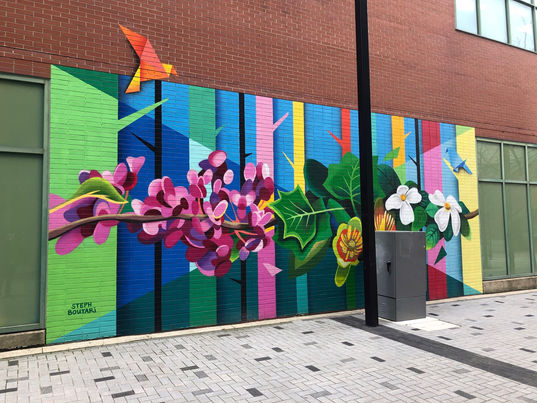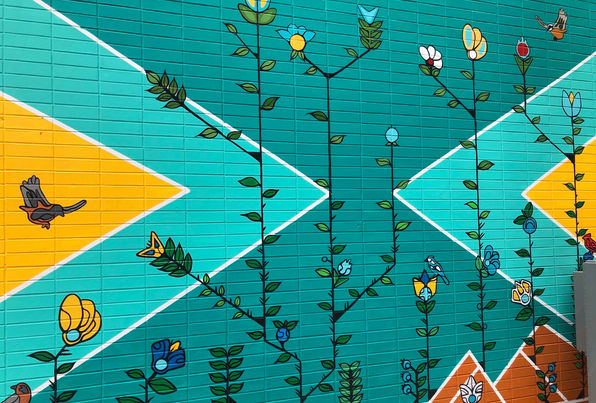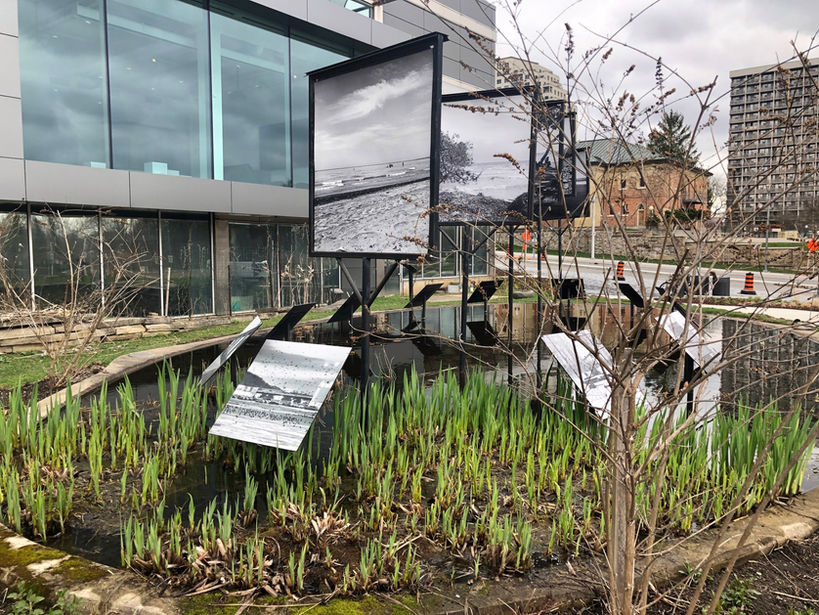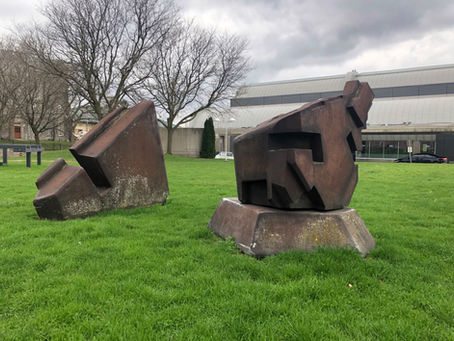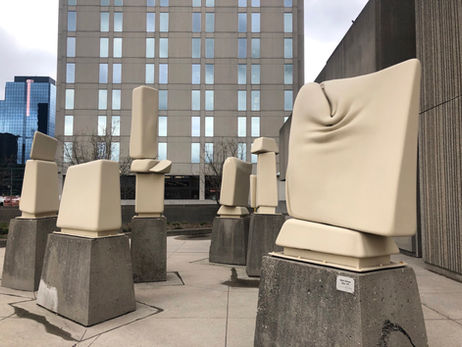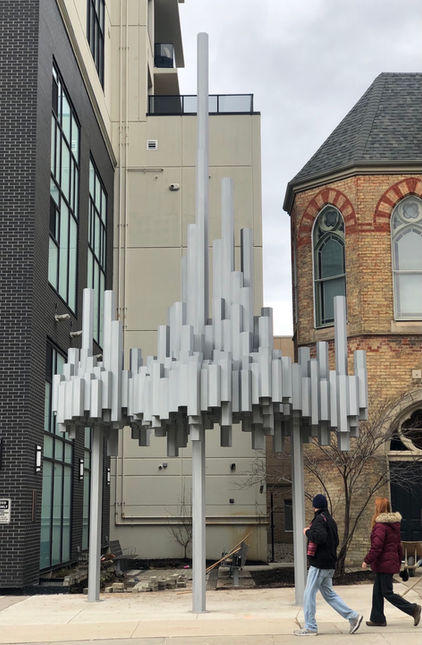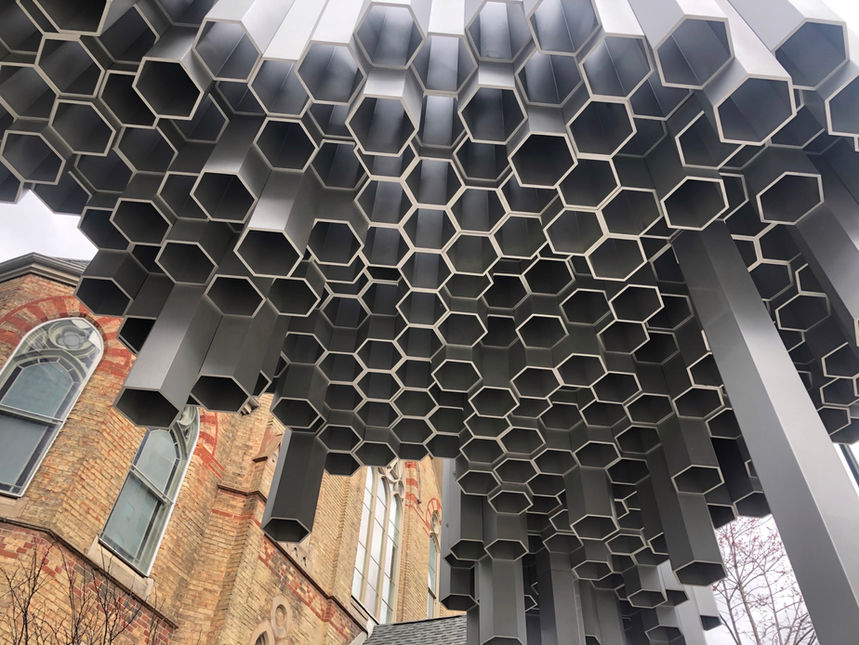
Public Art & Monument Tour
– Downtown Area –
Artwork: Site Lines by Jhyling Lee
The 'Public Art Now' Tour of London's Downtown features public artworks that many Londoners pass by often, whether on their commute to work or while shopping or attending a concert or sporting event. Through these informative and insightful podcast-style videos, there's the potential to begin to see these artworks differently - their surprising details and fascinating histories - breathing fresh life and understanding into our everyday surroundings, and inspiring us in our daily lives.
Each video features a conversation between local artist Amsa Yaro, and LAC's former Curator, Public Programs and Learning, Jeremy Jeresky, along with footage of the artworks captured by local videographer Stefan Sago.
This project was made possible through partnership with the City of London, and supported by the City of London's London Community Recovery Network (LCRN) Funds.
Locations Map

Public Art Locations
WE ARE STILL HERE
Mike Cywink, 2022
Seven (7) panel mural on the South side of the N'Amerind Friendship Centre (260 Colborne St.)
In 2022 Ojibwe educator and visual artist, Mike Cywink, together with N’Amerind Friendship Centre, The City of London, and the London Arts Council, created an expansive and historically significant mural on the South side of the N’Amerind Friendship Centre. The artwork is called We Are Still Here, a title which Cywink and a group of local Residential School Survivors decided upon to honorably reflect, give voice to, and commemorate their resilience and lives. It was officially unveiled on September 30, 2022, during a ceremony to honour the lives of Residential School Survivors and children who were lost through the Residential School System. Hailing from Whitefish River First Nation, Cywink has a longstanding and close relationship with N’Amerind’s community members, staff, and leaders. As a mentor, Cywink painted the mural with a group of Indigenous youths who sought to stimulate public conversation about the legacy of Canada’s Residential School System. Therefore, each of the seven (7) panels provide insights into the Seven Grandfather Teachings while telling the story of Canada’s Residential School Survivors, including the children who were lost through the system. However, We Are Still Here is also a story of hope, courage, new beginnings, and a celebration of Indigenous arts, culture, and knowledge. Cywink acknowledged this sentiment when he said “The ones who walked before us fought to keep our ways of life going. They ensured our teachings; ceremonies and our spiritual connections would live on. Through every action, their thoughts were with us. As we move forward together, we must never forget what has happened. We have survivors who walk amongst us, we have children of survivors who are dealing with intergenerational trauma and trying their best to break the cycle of pain and hurt. No matter what we do, we must always think of the next group coming next. Whether it is the youth of today, the newborns or the ones who are coming 7 generations from now. We must always think of them in everything we do.” Cywink designed and painted the mural in the Woodlands style, which builds on the Ojibwe traditions of petroglyphs (drawings or carvings on rocks) and images made on birchbark scrolls. Key features of this style are heavy black outlines and the inclusion of images within images. Another notable feature is the use of vibrant colour combinations. For more information about the mural, please visit: https://www.indigenouslondonarts.ca/
VIDEO TOUR
UNESCO CITY OF MUSIC MURAL
Tova Hasiwar, 2021
Five (5) panel mural on the main lobby bulkhead of RBC Place London (300 York St.)
On November 8, 2021, the City of London was recognized as Canada’s first UNESCO City of Music. What better way to celebrate this occasion than by the creation of a music-themed mural by one of London’s talented visual artists? Tova Hasiwar, a passionate supporter of the London music scene, worked with The City of London, the London Arts Council, and RBC Place London to paint a five-panel mural at RBC Place London – a place where people from all over the nation and the world come for special events, conferences, and conventions. Hasiwar’s process was rooted in her experience with the local music scene, the practice of process-based art, and her love of pop art. Brightly painted on fine mahogany boards, the mural features Hasiwar’s characteristic layered approach; deploying interlacing broad arcs, painted in a repeating series of crisp lines covered by an array of neon green spray-painted dots that depict sound waves on a digital monitor. All of this was done while live musical performances were happening in her studio. A series of resin dyed clear circular forms, reminiscent of vinyl records or CDs, repeat across the length of the mural, giving the impression of movement of both time and space – playing a visual and visceral cue to a song in the viewer’s mind. One thing is for certain, as Hasiwar remarks, “London draws talent from neighboring communities, weaving together a meaningful collaboration of various cultures and identities.” This unifying aspect, a harmony of sorts, flows through the entirety of the mural, doing the thing that music does best – connecting. To plan your visit, please check RBC Place London’s website for their operational hours: www.rbcplacelondon.com/upcoming-events
PEOPLE AND THE CITY
Stuart Reid and Doreen Balabanoff, 1991
Corner of Wellington St. and Queens Ave.

People and the City was designed by Stuart Reid and Doreen Balabanoff. Installed in 1991, it is a civic monument that pays tribute to the peoples of London, from its Indigenous roots, through the latter half of the 20th century. The central figure is a cross section of two profiles, one embodying the First Nations, the other representing John Graves Simcoe, the first lieutenant governor of Upper Canada. The artwork encompasses a solid flat bronze sheet with a series of cathedral like windows – evincing a medieval reliquary, that houses outlined silhouettes of notable figures from London’s past. Situated across the street (on the East side of Wellington) is a bronze map that labels each window and the names of the represented figures. For example, the top two windows portray Indigenous Peoples and Early Settlers, the middle windows feature people who are recognized in the fields of Politics and Law, Religious Leaders, Service and Activism, and Humanitarians, while the bottom six windows depict people celebrated for excellence in Philanthropy, Research, Education, Business, Industry and Labour, Sports and Entertainment, and the Arts. The form of the artwork references the city as a built construction, shaped by the forces of architecture and by the people who construct and reside in it. At the time of its fabrication, People and the City was created by cutting edge technology whereby a concentrated water jet spray, controlled by a computer program, slowly cut through the slab of bronze to create intricate forms out of negative space. A limestone base was constructed to give the sculpture further height and complement the bronze material.
VIDEO TOUR
FOREST CITY PLAYGROUND – MARKET LANE MURALS
Hawlii Pichette, Meaghan Claire Kehoe, and Stephanie Boutari, 2019
Market Lane (139 Dundas St.)
Image sourced from londontourism.ca
In 2019, three local artists were invited by the Downtown London Business Improvement Association and Tourism London to create a series of murals based on the Carolinian Forests of Southern Ontario. The first and last murals were painted by Hawlii Pichette, whose practice includes beadwork and visual art rooted in Indigenous ways of knowing and being. As a bead worker, Pichette gravitates towards florals which served as an aesthetic inspiration. Her mural also articulates the symmetry of the surrounding brick walls while complimenting the architecture of the space. Playful by nature, her mural features stylized blue jays, robins, cardinals, chickadees and nuthatches. The second mural, by Meaghan Claire Kehoe, symbolizes a coming of age. Certain flora and fauna found in the Carolinian Forest serve as a metaphor to tell a story about the artist’s relative, prominently featured, making her way through the end of her youth while trying to find her way in the world. As such, the Eastern Screech Owl symbolizes an ageless aspect of her sensibility. Swallows make their home in the Carolinian Forest and have several popular symbolic representations. One of them being rebirth or new beginnings. Another being the carriers of happiness and love. Historically, sailors have used swallow tattoos to signify how far they have travelled. In this regard, swallows also symbolize coming home, or a return. The Monarch butterfly is said to symbolize transformation and long journeys. The Black Oak leaves symbolize the wisdom of nature which accumulates over time. Lastly, Kehoe’s mural depicts a red sky and low sun – describing either a sun rise (a new beginning), or a sunset (a conclusion or resolution). The third mural was painted by Stephanie Boutari, who studied architecture before becoming a full-time visual artist. As such, there is a pervasive architectural sensibility in the mural’s composition. The abstracted trees create a very strong vertical presence which is further augmented by various wedge-shaped triangular branches. Notably, a large x made up of implied opposing diagonal lines runs from each corner. This creates illusionistic space by suggesting both upward and inward movement. Stephanie loves to take forest walks and wanted to convey feelings of looking up and travelling through trees and foliage. Depicted in the foreground are bold stylized representations - reminiscent of graffiti style tags – of three tree species of the Carolinian Forest. On the left is the Eastern Redbud. The middle one is the Tulip Tree, and the third one is the Flowering Dogwood.
VIDEO TOUR
THE GREAT BLUE HERON
Ted Goodden, 2010
Corner of King St. and Ridout St.
Created in 2010, The Great Blue Heron connects the towering Renaissance condominium to London’s natural geography, where the artist Ted Goodden regularly encountered a blue heron while kayaking on the Thames River. As a nature enthusiast, Goodden originally conceived of the design for this artwork in 1975, whilst creating experimental wire sculptures inspired by his interest in waterfowl. This unique aesthetic sensibility was eventually distilled into an organic simplified form, and is further accentuated by its installation, high up on the side of a building. A circle of stained glass, designed by Goodden’s friend, Peter Andre, adorns one wing of the linear sculpture. This luminously patterns the sidewalk with coloured light, which slowly moves as the earth orbits the sun. To articulate this feature, Andre hired a stone mason to make a tile, which was installed at a precise place on the ground to line up exactly with the colored light beam during the summer and winter solstice. Such a feature gives this artwork an otherworldly cosmic sensibility which reminds us of the passage of time.
VIDEO TOUR
GOOD HANDS
David Bobier and Leslie Putnam, 2011
Peace Garden, South end of Ivey Park (331 Thames St.)
Designed by artists David Bobier and Leslie Putnam, and installed in 2011, Good Hands honours the Tolpuddle Martyrs, considered originators of the British trade unionist movement in the 1830s. It was commissioned in collaboration with the London District Labour Union as part of the City of London’s Public Art Program. The monument’s two hands — one older, one younger — pay tribute to six agricultural labourers from Tolpuddle (in Dorset, England) who founded the Friendly Society of Agricultural Labourers in violation of British laws prohibiting collective bargaining by workers. After the Tolpuddle Martyrs served time in Australian penal colonies, popular outrage and one of Britain’s first successful political marches led to their pardoning. Five of the six eventually resettled in London, Ontario. Bobbier’s printmaking background influenced the linear style of this artwork. Unless one looks at the artwork from the front or the back, Good Hands appears to be an abstract convergence of flowing lines. To this point, Putnam and Bobier encourage the viewer to experience this artwork from as many different angles and perspectives as possible thereby inviting us to take our time with the process of apprehension.
VIDEO TOUR
AS THE CROW FLIES
Ron Benner, 2005
West side of Museum London on the corner of Dundas St. and Harris Park Gate
Image sourced from embassyculturalhouse.ca
As the Crow Flies is a living eco-based public art installation by internationally recognized Canadian artist Ron Benner. Benner’s photographic garden installations are in several collections including the National Gallery of Canada, the Art Gallery of Ontario, and Museum London. Large scale photographs, embedded in a built pond, illustrate Benner’s travels to locations where land meets water along the longitudinal meridian of London due South, including Port Stanley, Florida, Cuba, Panama, and Peru. Bridging the environment, politics and the economy, the images act as a compass that visually connect each location based on geographical flows of resources such as food and petroleum. Since the mid-70s Benner has mixed photography with organic materials like resins, plants, flowers, seeds, and crops. Generally speaking this artistic technique aims to disrupt or alter common assumptions. Disruptions or alterations, in this regard, can generate new or unknown realizations about nature based and socialized relationships. Installed in 2005, the photographic elements were integrated with a living pond-ecosphere, complete with local and nonlocal plants, flowers, insects, and animals. Such a fusion raises many open-ended questions for the viewer. Image sourced from the Embassy Cultural House website, www.embassyculturalhouse.ca.
VIDEO TOUR
WHITE RHINO (BIRTHA)
Tom Benner
West side of Museum London on Dundas St. off of Ridout St. (421 Ridout St. N)
Celebrated local artist Tom Benner (Ron Benner’s older brother – see his work As the Crow Flies above), has long held a passionate interest in the white rhino, and in educating people about this species’ perilous decline. Tom envisioned this artwork in a dream and was thus compelled to manifest his vision, which he nicknamed Birtha due to the process of it being “birthed” through his dreams. He chose to construct it with aluminum and rivets because it enabled him to make a life size sculpture by hand in his studio. The form was created piece by piece, folding and riveting each strip, over a 5-month period. The artwork was subsequently purchased by a Women’s volunteer group called the International Services of London who donated Birtha to the Museum in 1987. Here is a rather poignant story – several years ago, Birtha was entrenched in an initiation ritual wherein fraternity members were required to rip the horn off of the sculpture and steal it. Tom said that, during this time he had to replace Birtha’s horn six times. Finally, on one fateful evening, several students were caught on camera ripping off the horn. The students subsequently apologized and secretly dropped the damaged horn off at a location where Tom could retrieve it. That was the end of that until 2017, when two men were caught on camera plunging a steel bar into the body of the sculpture and into one of its legs. Tom said “that was a difficult and time-consuming repair. Every time that it happened, I was reminded of the heartbreaking cruelty, disregard, and lack of connection that some humans have to our environment. However, I stay hopeful that this will change.” You will be happy to know that Birtha has not suffered any more damage since.
VIDEO TOUR
LAMBETH WAY & TWO UNITS
Patrick Thibert and Walter Redinger, 1979 & 1974
South side of Museum London facing Ridout St. (421 Ridout St. N)
These are examples of public art from the 1960s – 80s, characterized as ‘modern’ art, that has been moved from the inside of the gallery into an outside public space. This movement could be experienced as an extension of the gallery. The public placement of these artworks (contrary to contemporary public art) do not attempt to speak or refer to their geographic, historical, and social elements that influenced the artist’s work because their essence (their aesthetic, concept and history) originate within the artwork itself, and within the gallery or art museum - including the embodiment of the artist. However, it is notable to suggest that Lambeth Way, created in 1979 by Canadian artist Patrick Thibert, and Two Units, created in 1974 by Canadian artist Walter Redinger are not really true examples of modern public art entirely, because they are in fact installed on the grounds of Museum London and as such they are pieces that speak to their surrounding context. Both of these artworks are in the style of minimalism, which was a predominate style in the art world (in the gallery, museum and in public art) in the 60s and 70s. Minimalist art characteristically seeks to distill its form down to its own material and processional nature whereby the object’s material and process of creation is illustrated or laid bare. Surprisingly, Redinger’s works, which at first look like heavy metal, are made out of fiberglass. He has been credited as being the first Canadian artist to experiment with, and use fiberglass as a medium for sculpture. Lambeth Way was purchased with funds from a volunteer committee and installed in 1996, and Two Units was gifted to Museum London in 2000. Both Thibert and Redinger are internationally renowned artists with work in collections all over the world.
VIDEO TOUR
XABIS
Walter Redinger, 1974
North side of the Ontario Court of Justice facing Queens Ave. (80 Dundas St.)
This is another of Walter Redingers’s works which was created in 1974. It was purchased by the provincial government and installed at the entrance of the Ontario Court of Justice. A strange choice of artwork given its whimsical nature, but perhaps such a sensibility was needed for a serious space of law and justice. Xabis is an example of minimalist inspired public art, in this case from Redinger’s ‘organic sculpture’ period, which depict assortments of either carefully placed or haphazardly stacked fiberglass forms that resemble fleshy shapes. These anthropomorphic sculptures create a feeling that they are in fact engaged in some kind of silent conversation that you may just glimpse a quip if you decide to enter their space. This series has been said, by critics, to inflect or demonstrate the particularly playful and softly fluid (which is to say, organic) formal influence of the British modern sculptor Henry Moore. During the 1970’s, the Federal and Provincial governments commissioned and purchased public artwork from Canadian artists and installed them on federal/ provincial property. Befitting of the time, the majority of these works were of the minimalist modern art tradition. Minimalist public art was a popular genre of artwork for federal and provincial commissioners because it was, and in some cases still is, believed that this style of artwork contains a universal appeal and understanding.
VIDEO TOUR
SITE LINES
Jhyling Lee, 2021
509 Talbot St.
Created in 2021 by visual artist Jhyling Lee, Site Lines connects to its historic, cultural and environmental context. As such, this artwork is considered to be ‘site specific’. In contrast to modern public art, Site Lines site was created with the location and setting in mind - the surroundings in fact shape the artwork itself. Lee comes from an architecture background, and has developed a preoccupation for designing public artworks that extend surrounding architectural forms. In this regard, Lee is interested in the viewer’s spatial and temporal experience as they approach, move through, perhaps stop under to look up, and then walk away from it. Indeed, Site Lines can be experienced differently, depending on if one experiences it from across the street, just a few feet away, or underneath it. Lee endeavoured to acknowledge London’s changing natural skyline by alluding to the forests that once dominated this landscape. She also aimed to acknowledge the changing built skyline by referencing the surrounding architectural history, particularly the prominent vertical lines, soaring spires and ornamentation of St. Peter’s (196 Dufferin Ave) and St. Paul’s (472 Richmond Street) cathedrals. Site Lines invites viewers to project their past and present experiences onto the meaning of the artwork.
VIDEO TOUR
THE SENTINEL
Gino Lorcini, 1983
Path near Walter J. Blackburn Memorial Fountain, Mitchell A. Baran Park (70 Riverside Dr.)
Watching over the Forks of the Thames stands a mysterious and quiet monolith. It’s smooth steel surface reflects the sun at dawn and dusk, while its imposing humanoid shape casts large shadows, like a community sundial, throughout the day. Art inspires our imaginations – and it is hard to tell if this towering figure is from the not-so-distant future or from the ancient past. Commissioned in 1983, the Sentinel, as its name typifies, embodies the characteristics of strength, courage, and vigilance. This is not surprising, as this public sculpture memorializes the arguably mythic life of one Walter J. Blackburn. Indeed, Walter singlehandedly helped to build the London Free Press by taking on the roles of reporter, editor, photographer, and printer. As a proponent of workers’ rights, he learned the business through close work with employees at all levels and — with the help of an employee committee that would become the Free Press Employees’ Association — instituted a five-day work week, a pension plan, and a medical plan for employees. Known as the Father of Broadcast News and “a man for all media,” he was posthumously inducted into the Canadian Association of Broadcasters Hall of Fame in 1999. The Sentinel was designed by the award-winning British sculptor Gino Lorcini, who for a time, lived in London, Ontario. As evident by the conceptual and formal sensibility of the Sentinel, Lorcini sought a diverse array of inspiration ranging from pre-historic monuments to minimalist art theory, and to interactions between natural and social spaces.























